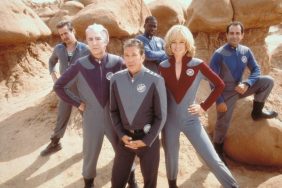Fred Topel is on an extended vacation to Risa. While he basks in the alien sunlight for six straight weeks, resident Trekkie Witney Seibold has taken over the reigns of Best Episode Ever, surmising ever ‘Star Trek’ series to date.
“Star Trek: Deep Space Nine” is most certainly the odd man out in the “Star Trek” franchise. For one, it was the first “Star Trek” show that had no creative say from Gene Roddenberry, who died in 1991, created by the franchise’s new gurus Rick Berman and Michael Piller. Secondly, it was the only “Star Trek” show where there was no, well, actual trekking involved; “Deep Space Nine” took place on a space station, and the “strange new worlds” had to come to them. Thirdly, the over-arcing theme of the show had less to do with the well-worn Trek notions of egalitarian peace and an ethos of pacificism, and far more to do with conflict, genocide, and war. “Deep Space Nine” was a disturbingly militaristic TV program, and featured the only time in “Star Trek” history wherein an outright war had been declared.
Some may call this a refreshing change of pace from the usual Trek tropes, as it allowed the Trek universe to expand beyond its usual life-aboard-an-interstellar-cruise-ship setting (seriously, the Enterprise-D was a plush, carpeted luxury vessel with bars, holodecks, gardens, schools, an an on-site therapist; they’re one martini buffet away from being a vacation). The titular station, DS9, was cold and metal and odd. It had previously been used as the central domination location for a military occupation-cum-genocide committed by a race called Cardassians over a race called the Bajorans. It was, metaphorically speaking, the place where Nazi soldiers would relax in between bouts of murdering Jews and minorities.

“Deep Space Nine” also showed us many smaller social facets of the “Star Trek” universe that we hadn’t seen before. We got to see businesses, for one; Quark’s bar was a central location on the station, and Garak’s clothing store was often alluded to. We got to see drink and drug. We got to see people actually using money (which confused some Trekkies; hasn’t it been said that there is no money in the future? I guess that only applies to Federation worlds). And we had some of that old-time religion; The Bajorans were a spiritual people whose version of The Pope (called The Kai) played a regular role on the show (and who was played by the awesome Louise Fletcher)! What’s more, the show’s main character, Captain Benjamin Sisko (Avery Brooks) was said to be a key religious figure to many Bajorans (he was the first to contact a race of 4th-dimensional aliens called The Prophets, making him The Emissary).
So we’re in a topsy-turvy Trek world with “Deep Space Nine.” I have read that some Trekkies even feel betrayed by it’s war fixation, seeing as the entire notion of “Star Trek” was a previously a message of peace and togetherness. But flirting with war was a common trope before (how many times did an Enterprise almost start a war with the Romulans or the Klingons?), and it only makes sense that Trek writers would eventually get bored with all the pussyfooting and just have the bloody war already. It’s counter to what we know, but, from a dramatic standpoint, it makes sense.

The episode of the show I choose to cite as its best, however, has nothing to do with war or even to do with the station itself. The best episode of “Star Trek: Deep Space Nine” was “Far Beyond the Stars” from the show’s sixth season, originally airing on February 11th, 1998. It was written by Marc Scott Zicree and directed by Avery Brooks.
“Far Beyond the Stars” is DS9 in full-tilt “Twilight Zone” mode. It posits a parallel universe featuring the show’s same cast, but all in entirely new roles. And this is not the wormhole-colossal-negative-space-wedgie-science-fiction-y type of parallel universe. This is just an outright dream. Little explanation is given for why it happens. Captain Sisko just begins imagining himself (or perhaps actually living) on 1950s Earth. There is some explanation for these visions (he is experiencing a cerebral drift akin to the type he had in a previous episode), but the way it plays out is far more incidental.
Sisko wakes up in the 1950s, imagining himself to be a pulp author named Benny Russell, a black man who is loved by his co-workers (most of the rest of the cast) who run a modest pulp sci-fi book empire. This is the 1950s, however, so Benny’s race has been politely eschewed in his author profile. The only female writer at the firm (Nana Visitor) has to eschew her sex in a similar fashion.






